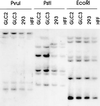Loss of the retinoblastoma protein-related p130 protein in small cell lung carcinoma
- PMID: 9192669
- PMCID: PMC21262
- DOI: 10.1073/pnas.94.13.6933
Loss of the retinoblastoma protein-related p130 protein in small cell lung carcinoma
Abstract
The retinoblastoma gene family consists of the tumor suppressor protein pRB and its two relatives p107 and p130. These proteins have been implicated in the regulation of cell cycle progression, in part, through inactivation of members of the E2F transcription factor family. Overexpression of pRB, p107, or p130 leads to growth arrest in the G1 phase of the cell cycle, and this arrest is abolished by complex formation with the adenovirus E1A, human papilloma virus E7, or simian virus 40 T oncoproteins. Inactivation of pRB by gross structural alterations or point mutations in the RB-1 gene has been described in a variety of human tumors, including retinoblastomas, osteosarcomas, and small cell lung carcinomas. Despite the structural and functional similarity between pRB, p107, and p130, alterations in the latter two proteins have not been identified in human tumors. We have screened a panel of 17 small cell lung carcinoma cell lines for the presence of functional p107 and p130 by evaluating their ability to form complexes with E1A in vitro. In the GLC2 small cell lung carcinoma cells no p130 protein was detected. The loss of the p130 protein is the result of a single point mutation within a splice acceptor sequence in the GLC2 genomic DNA. This mutation eliminates exon 2, leading to an in-frame stop codon, and no detectable protein is produced. These data are, to our knowledge, the first to describe the loss of p130 as a consequence of a genetic alteration, suggesting that not only pRB but also the other members of the family may contribute to tumorigenesis, providing a rationale for the observation that the DNA tumor viruses selectively target all the members of the retinoblastoma protein family.
Figures





References
Publication types
MeSH terms
Substances
LinkOut - more resources
Full Text Sources
Medical
Miscellaneous

